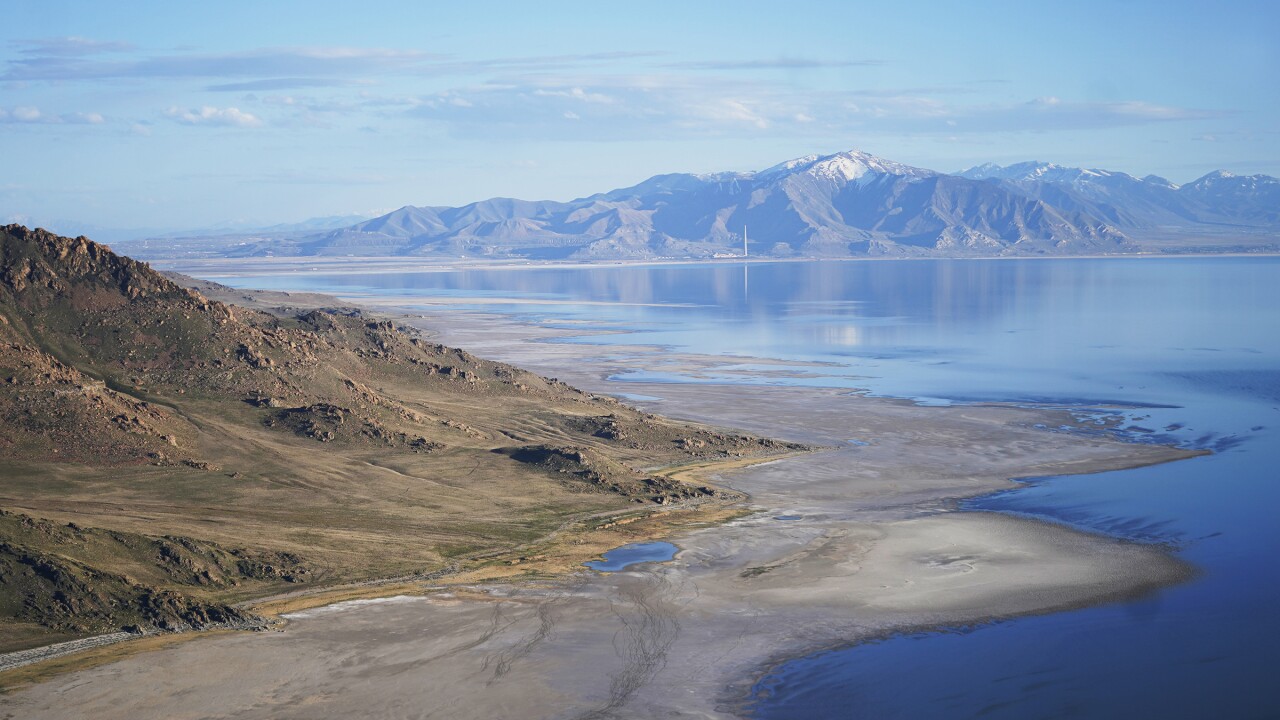SALT LAKE CITY — The Great Salt Lake has dropped low enough that forced conservation measures will be enacted.
During a news conference on Tuesday, Great Salt Lake Commissioner Brian Steed — tasked by Utah political leaders with coming up with a plan to save the lake — told reporters that the lake has hit 4,192 feet on the south arm, "the last metric we measure to say now the lake’s really in trouble."
"That is not great news," Steed said.
The shrinking Great Salt Lake presents a public health and ecological crisis for northern Utah. The lake helps generate snowpack, which provides drinking water. It is a refuge for millions of migratory birds. Billions of dollars of Utah's economy are also tied to the lake through mineral extraction and even the ski industry. The lake's declines, as a result of water diversions and impacts from drought and a changing climate, lead to exposed lake bed and potentially toxic dust storms (arsenic and other minerals are naturally occurring in the lake).
Under new laws passed by the Utah State Legislature, the new lake level triggers some mandatory conservation measures. Mineral companies that work on the lake will be forced to take less water. Compass Minerals, which struck a deal with the state for water based on lake levels, told FOX 13 News it is already taking less.
"Based on the lake elevation at the annual benchmark date of June 15, Compass Minerals’ brine water right from the lake would be reduced by approximately 50% in calendar year 2026. In fact, our company has proactively adjusted operations and is already using significantly less than our allowed amount," Compass Minerals said in a statement.
"Our operations are expected to use a fraction of our brine water right in 2025, with a similar consumption profile expected in 2026. Our ability to dramatically reduce our brine consumption when the lake is at lower levels is a testament to the investments and innovations we have undertaken in the past 10 years, and our commitment to help ensure a healthy and sustainable Great Salt Lake."
Agriculture, the state's top water user, has already seen reductions.
"Every time water levels drop, we see agriculture producers being cut off," Steed told FOX 13 News. "That’s important to note. In addition to that, they’ve taken really meaningful steps in terms of agriculture water optimization so we’re going to use water more effectively."
But local water districts report residential water use has increased and Steed urged people to reduce their outdoor watering. He also called for an end of pitting one sector against another to make changes.
"It's all of us," he said.
That view was somewhat shared by Deeda Seed of the Center for Biological Diversity, which is actively suing the state of Utah over how it has handled the Great Salt Lake.
"We’re facing a crisis of our own making here and we can unmake it," she told FOX 13 News on Tuesday, adding: "Each water user, from agricultural users to industrial users to residential, municipal, we all have our roles to play in this. There needs to be urgency in this crisis."
Seed said state leaders must still do more to ensure water for the Great Salt Lake.
"We don’t have the water resources to have a healthy Great Salt Lake and this unfettered development that we’re experiencing in northern Utah. That’s really what’s at issue here. We want our cake and eat it, too," she said.
While we are not at the record low levels seen in 2022 when the Great Salt Lake dropped to 4,188 feet, Steed said the laws have changed and there are more measures they can take to help the lake. Some of those take time to fully enact.
"We’re not just reacting—we’re ready. With improved technology, stronger planning, and new tools in place, Utah is better prepared than ever to respond when Great Salt Lake levels drop. This is a long-term challenge, and we’re committed to protecting and improving the lake for current and future generations," House Speaker Mike Schultz, R-Hooper, said in a statement to FOX 13 News.
"We urge the general public to join us in this effort by conserving water and supporting conservation measures. The legislative efforts of the past five years have laid a foundation for proactive measures aimed at mitigating the impacts of low lake levels, ensuring that our actions today safeguard the Great Salt Lake."
Speaker Schultz called for a "pause" on major water legislation in 2024 to evaluate what is working and what isn't when it comes to saving the lake.
"So far, we’ve really been skirting around this with incentive programs and different scenarios and so forth. So now, headed into this new version of this crisis we’ll see how willing state elected leaders are to take the action that’s absolutely needed to protect the lake," Seed said.
The Great Salt Lake Commissioner said he will meet with legislative leaders on next steps.
A silver lining, Steed said, is that salinity remains healthy, as the state has changed tactics of managing the north and south arms of the lake together by keeping a berm on the Great Salt Lake Causeway open. While that has led to lower water levels, it has reduced salinity spikes that impact wildlife.
The entire state is now in drought. A small portion of Box Elder County, a major agricultural area of Utah, is now in "extreme" drought conditions.
This article is published through the Great Salt Lake Collaborative, a solutions journalism initiative that partners news, education and media organizations to help inform people about the plight of the Great Salt Lake—and what can be done to make a difference before it is too late. Read all of our stories at greatsaltlakenews.org.




